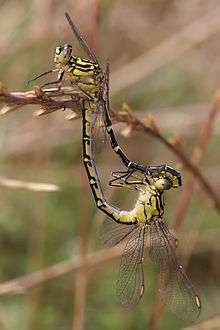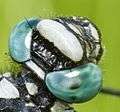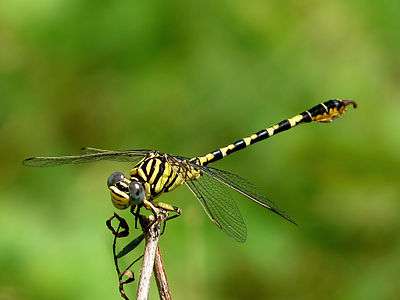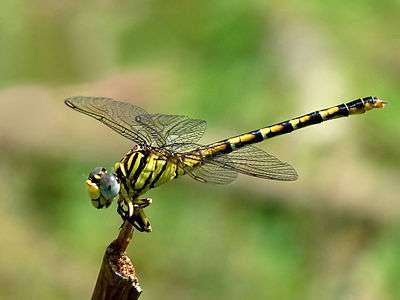Gomphidae
The Gomphidae are a family of dragonflies commonly referred to as clubtails or club-tailed dragonflies. The family contains about 90 genera and 900 species found across North and South America, Europe, Asia, and Australia.[2] The name refers to the club-like widening of the end of the abdomen (abdominal segments 7 through 9). However, this club is usually less pronounced in females and is entirely absent in some species.
| Gomphidae | |
|---|---|
_male_Macedonia.jpg) | |
| Bladetail, male, Lindenia tetraphylla North Macedonia | |
| Scientific classification | |
| Kingdom: | Animalia |
| Phylum: | Arthropoda |
| Class: | Insecta |
| Order: | Odonata |
| Infraorder: | Anisoptera |
| Family: | Gomphidae Rambur, 1842[1] |
| Genera | |
|
See text | |
Etymology
The name may be derived from Latin gomphus or gond meaning "hinge".
Characteristics
Clubtails have small, widely separated compound eyes, a trait they share with the Petaluridae and with damselflies. The eyes are blue, turquoise, or green. The thorax in most species is pale with dark stripes, and the pattern of the stripes is often diagnostic. They lack the bright metallic colors of many dragonfly groups and are mostly cryptically colored to avoid detection and little difference between the sexes is seen.[3] Adults are usually from 40 to 70 mm (1.6 to 2.8 in) in length.
Clubtails are fast-flying dragonflies with short flight seasons. They spend much time at rest, perching in a suitable position to dart forth to prey on flying insects. They tend to perch on the ground or on leaves with the abdomen sloping up and its tip curling down a little. Larger species may perch with a drooping abdomen or lie flat on a leaf. Another stance adopted by clubtails perching in the open is "obelisking", standing with the abdomen raised vertically, a posture adopted otherwise only by the skimmers.[3]
Most clubtails breed in streams, rivers, or lakes. The nymphs are unusual in having a flat mentum, part of the mouthparts, and their antennae have only four segments. They burrow in the sediment at the bottom of the water body, with the nymphs of the dragonhunter (Hagenius brevistylus) living among damp bark and leaf litter at the edge of the water.[4]
Gallery
 Gomphidae wing structure: Note the similar-sized triangles of the front and hind wings and the widely separate eyes.
Gomphidae wing structure: Note the similar-sized triangles of the front and hind wings and the widely separate eyes. Pair of yellow-striped hunters mating
Pair of yellow-striped hunters mating_W_IMG_0224.jpg) Common clubtail, Ictinogomphus rapax
Common clubtail, Ictinogomphus rapax Gomphus vulgatissimus, showing the "clubbed" abdomen characteristic of the family
Gomphus vulgatissimus, showing the "clubbed" abdomen characteristic of the family The common clubtail Gomphus vulgatissimus head with widely separated eyes
The common clubtail Gomphus vulgatissimus head with widely separated eyes Paragomphus lineatus, male
Paragomphus lineatus, male Paragomphus lineatus, female
Paragomphus lineatus, female
Genera
These genera belong to the family Gomphidae.[5]
- Acrogomphus Laidlaw, 1925
- Agriogomphus Selys, 1869
- Amphigomphus Chao, 1954
- Anisogomphus Selys, 1858
- Anomalophlebia Belle, 1995
- Anormogomphus Selys, 1854
- Antipodogomphus Fraser, 1951
- Aphylla Selys, 1854
- Archaeogomphus Williamson, 1919
- Arigomphus Needham, 1897
- Armagomphus Carle, 1986
- Asiagomphus Asahina, 1985
- Austrogomphus Selys, 1854
- Brasiliogomphus Belle, 1995
- Burmagomphus Williamson, 1907
- Cacoides Cowley, 1934
- Ceratogomphus Selys, 1854
- Cinitogomphus Pinhey, 1964
- Cornigomphus Martin, 1907
- Crenigomphus Selys, 1892
- Cyanogomphus Selys, 1873
- Cyclogomphus Selys, 1854
- Davidioides Fraser, 1924
- Davidius Selys, 1878
- Desmogomphus Williamson, 1920
- Diaphlebia Selys, 1854
- Diastatomma Burmeister, 1839
- Dromogomphus Selys, 1854
- Dubitogomphus Fraser, 1940
- Ebegomphus Needham, 1944
- Eogomphus Needham, 1941
- Epigomphus Hagen in Selys, 1854
- Erpetogomphus Selys, 1858
- Euthygomphus Kosterin, 2016
- Fukienogomphus Chao, 1954
- Gastrogomphus Needham, 1941
- Gomphidia Selys, 1854
- Gomphidictinus Fraser, 1942
- Gomphoides Selys, 1854
- Gomphurus Needham, 1901
- Gomphus Leach in Brewester, 1815
- Hagenius Selys, 1854
- Heliogomphus Laidlaw, 1922
- Hemigomphus Selys, 1854
- Hylogomphus Needham, Westfall & May, 2000
- Ictinogomphus Cowley, 1934
- Idiogomphoides Belle, 1984
- Isomma Selys, 1892
- Labrogomphus Needham, 1931
- Lamelligomphus Fraser, 1922
- Lanthus Needham, 1897
- Leptogomphus Selys, 1878
- Lestinogomphus Martin, 1911
- Lindenia de Haan, 1826
- Macrogomphus Selys, 1858
- Malgassogomphus Cammaerts, 1987
- Mastigogomphus Cammaerts, 2004
- Megalogomphus Campion, 1923
- Melanocacus Belle, 1986
- Melligomphus Chao, 1990
- Merogomphus Martin, 1904
- Microgomphus Selys, 1858
- Mitragomphus Needham, 1944
- Neogomphus Selys, 1858
- Nepogomphoides Fraser, 1934
- Nepogomphus Fraser, 1934
- Neurogomphus Karsch, 1890
- Nihonogomphus Oguma, 1926
- Notogomphus Selys, 1858
- Nychogomphus Carle, 1986
- Octogomphus Selys, 1873
- Odontogomphus Watson, 1991
- Onychogomphus Selys, 1854
- Ophiogomphus Selys, 1854
- Orientogomphus Chao & Xu, 1987
- Paragomphus Cowley, 1934
- Perigomphus Belle, 1972
- Perissogomphus Laidlaw, 1922
- Peruviogomphus Klots, 1944
- Phaenandrogomphus Lieftinck, 1964
- Phanogomphus Carle, 1986
- Phyllocycla Calvert, 1948
- Phyllogomphoides Belle, 1970
- Phyllogomphus Selys, 1854
- Platygomphus Selys, 1854
- Praeviogomphus Belle, 1995
- Progomphus Selys, 1854
- Scalmogomphus Chao, 1990
- Shaogomphus Chao, 1984
- Sieboldius Selys, 1854
- Sinictinogomphus Fraser, 1939
- Sinogomphus May, 1935
- Stenogomphurus Carle, 1986
- Stylogomphus Fraser, 1922
- Stylurus Needham, 1897
- Tibiagomphus Belle, 1992
- Tragogomphus Sjöstedt, 1899
- Trigomphus Bartenev, 1911
- Zonophora Selys, 1854
References
- Rambur, Jules (1842). Histoire naturelle des insectes. Névroptères (in French). Paris: Librairie Encyclopédique de Roret. pp. 534 [24] – via Gallica.
- "New Hampshire PBS web article"
- Paulson, Dennis (2009). Dragonflies and Damselflies of the West. Princeton University Press. p. 237. ISBN 1-4008-3294-2.
- John L. Capinera (2008). Encyclopedia of Entomology. Springer Science & Business Media. p. 1245. ISBN 978-1-4020-6242-1.
- "Odonata Central, Dragonfly & Damselfly World Catalog, Family Gomphidae". odonatacentral.org. Retrieved 2018-05-13.
External links
| Wikimedia Commons has media related to Gomphidae. |
| Wikispecies has information related to Gomphidae |